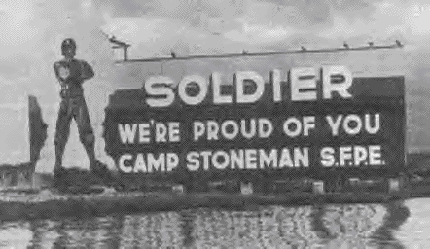Camp Stoneman
Here is what I have found on the "Jumping off point" 
Though the sound of thousands of marching feet is but a memory today, not so very long ago Camp Stoneman was the principal "jumping off point" for more than one million American soldiers destined for military operations in the Second World War's Pacific Theater, and again several years later during the Korean War. Consisting of more than 2,500 sprawling acres, Camp Stoneman sprang to life near the town of Pittsburg in 1942 to act as the San Francisco Port of Embarkation's primary troop staging center. The function of the post was to receive and rapidly process troops for overseas service by completing paperwork and -updating records, arranging for last minute training, providing medical and dental care, and issuing and servicing equipment.
Camp Stoneman, named after a Civil War cavalry commander and early Governor of California, had a life span of only 12 years, being activated on May 28, 1942, and decommissioned on August 30,1954. Most troops staging at the post before transportation overseas arrived aboard trains which steamed directly into the installation on spurs from both the Santa Fe and Southern Pacific mainlines. Although soldiers sometimes traveled to pier side at Fort Mason by truck convoy, most often they traveled by water via the Army's small ferry fleet. This fleet consisted of the former excursion boats Catalina and Cabrillo and the one million-dollar ferry Yerba Buena, which changed its name late in the war to the "Ernie Pyle."
The day-to-day operation of Camp Stoneman was a tremendous task. In addition to receiving, processing and embarking thousands of troops each week, waiting soldiers were housed and fed, medical and dental examinations and corrective work conducted, clothing, equipment and records put in proper order, final training provided, and numerous other odds and ends taken care of. Delays and mistakes resulted in problems at embarkation piers and overseas areas, so maximum attention was directed toward ensuring everything was done right At Camp Stoneman, there was no time for a second try.
Camp Stoneman consisted of more than 800 cream and khaki-colored buildings, capable of accommodating 20,000 troops at peak capacity. The average length of a stay for troops bound overseas was one to two weeks. When soldiers returned at the conclusion of World War 11 and the Korean Conflict, the average person was cleared out in less than 48 hours. A number of conveniences were maintained at the installation for use by the soldiers who were often restricted to post during their entire stay. The camp boasted three motion picture theaters, a ten-thousand seat outdoor theater, weekly USO shows throughout much of World War 11, eight well-stocked branches of the Post Exchange, a huge service dub, and much more. USO show entertainers included Hollywood stars such as Groucho Marx, Gary Moore and Red Skeleton. As specified by Army Regulations, profits from Post Exchange sales (which were considerable due so mammoth purchases by soldiers seeking to "stock up before going overseas) were used to finance projects for the enjoyment of the soldiers.
In an effort to ensure that only physically fit troops were sent for overseas duty everyone underwent complete medical examinations upon arrival at Camp Stoneman. This included a battery of inoculations to prevent diseases peculiar to Pacific destinations. An array of 45 dentists chairs were kept busy on an 18-hour schedule that saw many examinations conducted and teeth filled.
When the Second World War and the Korean Conflict each drew to a close, Camp Stoneman switched gears to become a separation center. Returning troopships were discharged at Fort Mason where soldiers were greeted by entertainers, an Army band, Red Cross volunteers passing out donuts, and coffee, and relatives and friends. The soldiers were then loaded aboard a ferry for the three-hour ride to Camp Stoneman.
Various "welcome home" signs greeted them along the way. A sign proclaiming "Welcome Home - Well Done" had been erected on Angel Wand, another on the side of the C&H sugar refinery passed by ferries near Crockett and yet another gracing the Southern Pacific Railroad bridge between Martinez and Benicia. Upon reaching the decorated Pittsburg docks, a "welcome home" private cabin cruiser pulled along side ferries of returning hoops. The complement of "wavers" aboard each boat included local high school students, female GI's from Camp Stoneman, and other local civilians.
Camp Stoneman's primary mission had changed to one ensuring that returning soldiers returned to their homes as soon as possible. Although maximum use was made of the rail transportation mode, some lucky soldiers were able to travel home by air aboard C-47 transports from nearby McClellan Field. Many soldiers residing on the West Coast reboarded transports due to shortages of ground transportation. A big benefit of this innovation was that it allowed many returnees to spend the Christmas of 1945 with their families rather than awaiting transportation at a military post
The largest telephone center in the world was operated at Camp Stoneman in 1945, consisting of 75 phone booths capable of handling 2,000 operator-assisted long distance telephone calls each day. One of the first spots visited by soldiers returning from overseas duty, telephone service was operated on a 24-hour basis. A telegraph office was also located on base, with the must frequent message being, "Arrived safely, be home soon."
Although Camp Stoneman's lifetime was relatively brief, it touched the lives of hundreds of thousands of Americans and helped bring two wars to successful conclusion. Nearly all the old buildings which once made up the post are gone now, but the many men and women who operated it as a marvel of modern efficiency can truly state, "Mission Accomplished."
